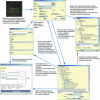Onto-Tools: an ensemble of web-accessible, ontology-based tools for the functional design and interpretation of high-throughput gene expression experiments
- PMID: 15215428
- PMCID: PMC441547
- DOI: 10.1093/nar/gkh409
Onto-Tools: an ensemble of web-accessible, ontology-based tools for the functional design and interpretation of high-throughput gene expression experiments
Abstract
The Onto-Tools suite is composed of an annotation database and five seamlessly integrated web-accessible data mining tools: Onto-Express (OE), Onto-Compare (OC), Onto-Design (OD), Onto-Translate (OT) and Onto-Miner (OM). OM is a new tool that provides a unified access point and an application programming interface for most annotations available. Our database has been enhanced with more than 120 new commercial microarrays and annotations for Rattus norvegicus, Drosophila melanogaster and Carnorhabditis elegans. The Onto-Tools have been redesigned to provide better biological insight, improved performance and user convenience. The new features implemented in OE include support for gene names, LocusLink IDs and Gene Ontology (GO) IDs, ability to specify fold changes for the input genes, links to the KEGG pathway database and detailed output files. OC allows comparisons of the functional bias of more than 170 commercial microarrays. The latest version of OD allows the user to specify keywords if the exact GO term is not known as well as providing more details than the previous version. OE, OC and OD now have an integrated GO browser that allows the user to customize the level of abstraction for each GO category. The Onto-Tools are available online at http://vortex.cs.wayne.edu/Projects.html.
Figures


References
-
- Bankier A.T. (2001) Shotgun DNA sequencing. Methods Mol. Biol., 167, 89–100. - PubMed
-
- Craig J.C., Adams,M.D., Myers,E.W., Li,P.W., Mural,R.J., Sutton,G.G., Smith,H.O., Yandell,M., Evans,C.A., Holt,R.A., et al. (2001) The sequence of the human genome. Science, 291, 1304–1351. - PubMed
-
- Golub T.R., Slonim,D.K., Tamayo,P., Huard,C., Gaasenbeek,M., Mesirov,J.P., Coller,H., Loh,M.L., Downing,J.R., Caligiuri,M.A., Bloomfield,C.D. and Lander,E.S. (1999) Molecular classification of cancer: class discovery and class prediction by gene expression monitoring. Science, 286, 531–537. - PubMed
-
- Lockhart D.J., Dong,H., Byrne,M.C., Folletie,M.T., Gallo,M.V., Chee,M.S., Mittmann,M., Want,C., Kobayashi,M., Horton,H. and Brown,E.L. (1996) DNA expression monitoring by hybridization of high density oligonucleotide arrays. Nat. Biotechnol., 14, 1675–1680. - PubMed
MeSH terms
Grants and funding
LinkOut - more resources
Full Text Sources
Other Literature Sources
Molecular Biology Databases

